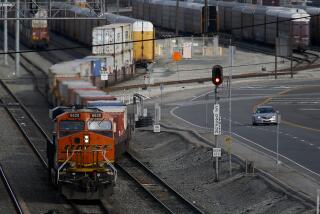Pollution rules for ships OKd
California regulators adopted the world’s toughest pollution rules for oceangoing vessels Thursday, vowing to improve the health of coastal residents and opening a new front in a long battle with the international shipping industry.
The rules, which take effect in 2009, would require ships within 24 nautical miles of California to burn low-sulfur diesel instead of the tar-like sludge known as bunker fuel. About 2,000 vessels would be affected, including container ships, oil tankers and cruise ships.
International negotiators have struggled for decades to reduce pollution from oceangoing vessels but have been stymied by opposition from shipping conglomerates.
Federal legislation to control vessel emissions in U.S. ports, sponsored by Sens. Barbara Boxer and Dianne Feinstein, both California Democrats, has been opposed by the Bush administration, which favors deferring to future international regulations.
California’s new regulation will have a global effect: 43% of all marine freight imported into the United States, much of it from Asia, moves through the ports of Los Angeles and Long Beach.
California “needs to act now,” Air Resources Board Chairwoman Mary Nichols said. “We’ve known for years that a large percentage of onshore pollution comes from activities in the water. Our ports need to expand and modernize, but the adjacent communities are not willing to tolerate the health risks.”
The rules could save 3,600 lives in coastal communities over the first six years through reduced respiratory illnesses and heart disease, including a potential 80% drop in cancer risk associated with ship pollutants, according to regulators.
Nichols called the shipping regulation “the single most significant rule the Air Resources Board has adopted in the last five years.”
Because prevailing winds blow from west to east in California, ship exhaust accounts for about a fifth of cancer-causing soot particles and half of the sulfur oxides over land.
The remainder is emitted by diesel-powered trucks, construction equipment, locomotives, industrial engines and agricultural pumps, which are all to be subject to stricter regulation as the state seeks to slash the emission of planet-warming greenhouse gases and other pollutants.
The air board estimates that the new shipping rules will save Californians at least $6 billion a year in health-related expenses and will cost the shipping industry between $140 million and $360 million a year.
A typical cargo ship would pay about $30,000 more in fuel costs for each visit, or about $6 per container shipped from Asia to California. That amounts to 0.1 cent per pair of sneakers, the board noted.
Environmentalists and community groups praised the rules.
“This is a huge victory for clean air and public health,” said Candice Kim of the Coalition for Clean Air. “Ten Californians die every day due to air pollution from ports and freight transportation.”
Shippers fiercely oppose the limits, saying that California lacks jurisdiction to regulate beyond the 3-mile limit of state waters, and that low-sulfur fuel is in short supply, particularly in Asian ports.
The San-Francisco based Pacific Merchant Shipping Assn. last year won a court victory halting the state’s previous effort to control shipping pollution by regulating engine emissions. The air board believes that a fuel regulation will stand up to a court challenge, but John McLaurin, the shipping association’s president, wrote the board this week that the regulation “simply rehashes and represents old arguments that have already failed to pass judicial muster.”
The rules would “govern the internal operation of foreign vessels . . . require the ships to purchase the required fuel in foreign ports, and, in many cases, to retrofit their tanks, piping and engines,” McLaurin wrote.
It was unclear Thursday whether the shipping industry would challenge the regulations in court.
California’s rule would be implemented in two phases. Beginning July 1, 2009, shippers would be required to use diesel oil with a sulfur limit of 0.5%. On Jan. 1, 2012, that would be reduced to 0.1% sulfur, a level that would cut soot by 83%, sulfur oxides by 95% and nitrogen oxides by 6%.
By contrast, the United Nations’ International Maritime Organization allows fuel that is 4.5% sulfur. IMO negotiators will meet in October and are expected to consider new limits, but those would not take effect until 2015 or later.
Shippers asked that the California board defer any action until international rules take effect. In a compromise, the board voted Thursday to allow its executive director to suspend California’s regulation “if and when the IMO or the federal government adopts a rule as effective as California’s,” Nichols said.
Meanwhile, fines for noncompliance would be stiff. Vessels using fuel over the sulfur limit would pay a fee beginning at $45,500 for each visit, with a maximum of $227,500 on the fifth visit.
“In theory, a vessel that makes 10 calls to California would be subject to paying $1,365,000 the first year, and $2,275,000 each subsequent year,” the shipping association protested.
Board officials said that international law allows California to regulate ship emissions as long as they affect its residents. The board’s scientists studied pollution effects out to the 3-mile limit, the 12-mile limit and the 24-mile limit, and found that “emissions from 24 miles out directly impact the majority of our population,” Nichols said.
Representatives of the Navy have expressed concern that vessels would be more likely to travel through their offshore testing and training range once the rule is implemented. But Air Resources Board staff pledged to work with Navy officials to address their concerns.
--
More to Read
Sign up for Essential California
The most important California stories and recommendations in your inbox every morning.
You may occasionally receive promotional content from the Los Angeles Times.











